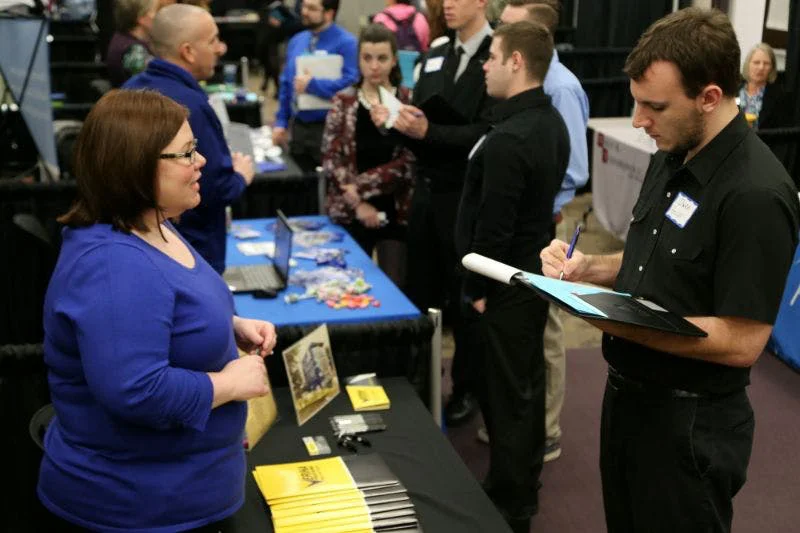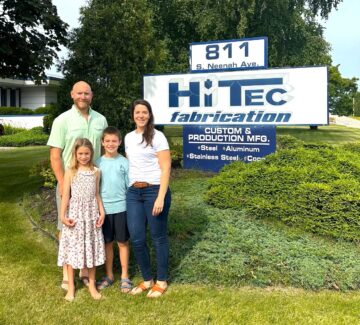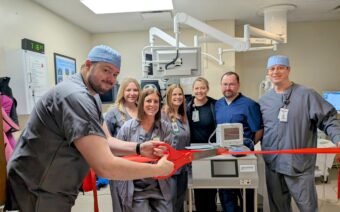
September 12, 2022
NORTHEAST WISCONSIN – Any business that has vacant positions they are trying to fill will tell you – grabbing a candidate’s attention in this day and age is not an easy task.
“The old thought process used to be, create jobs and people will come,” Eric Vanden Heuvel, vice president of talent and education for the Greater Green Bay Chamber, said. “Now the thought process is getting people to be in your community and then they can support the jobs.”
Vanden Heuvel said the difference is subtle, but it’s different from the historical approach to economic development, community growth and business success.
“We have the recipe here in our community to be successful at this,” he said. “It’s going to be a matter of accepting the new reality and changing the approaches in order to be effective with that.”
Amy Sabourin, executive vice president of human resources and associate services at J. J. Keller & Associates, Inc., said the hiring landscape is competitive.
“We’ve found that what most motivates our associates is work-life balance/flexibility and commitment to our purpose of protecting people and the businesses they run,” she said.
Sabourin said being an employer of choice is not a quick fix but a long game.
“If you weren’t doing the right things to create a great workplace before, you’re not going to have prospective talent suddenly believe you are once the market gets tough,” she said. “You need to position yourself as a strong employer at all times.”
Vanden Heuvel said the No. 1 piece of attracting talent has to start with company culture – noting it is no longer a non-negotiable.
//s3.amazonaws.com/appforest_uf/f1662990841217x605753348697643000/richtext_content.webp
Eric Vanden Heuvel
“If your workplace doesn’t show in a variety of forms that you are flexible, that you’re finding benefits, that you’re showing them you value them – that’s really a non-starter,” he said. “People aren’t going to tolerate a culture that doesn’t show those things that are important to them.”
Vanden Heuvel said many companies approach talent attraction as a compensation race – thinking they need to offer $1 more per hour than competitors.
“While that is certainly a part of it – you need to offer competitive wages, if all of the other things about your culture are strong, the dollar more per hour isn’t going to be what tips the scales,” he said. “So continuing to try to fight that fight, may help get people in the door, but what’s going to keep them are all the other things they want in their job.”
Vanden Heuvel said this is an evolution of what economic development is.
“If we’re going to create a strong community, we’re going to have strong businesses and companies who provide high wages and support a growing community,” he said. “This is what it takes. This is what economic development looks like.”
Jayme Sellen, executive director of Oconto County Economic Development Corporation, said employers had to not only evaluate their benefits and pay, but their workplace culture as well.
“Making sure it is a positive culture that embraces new employees, mentors them and provides them with professional development opportunities to not only increase their skills, but retain them as an employee,” she said. “It used to be just filling spots, now it’s focusing on keeping your current employees, keeping that current knowledge and then adding to it.”
Sellen said the next generation of employees that are entering the workforce, want the job, but always want a life outside of work.
“They want to be part of the community,” she said. “They want to know that when they’re not working, there’s things for them and their families to do. There’s opportunities for their spouses or their children to be part of a community and grow relationships. And I think that’s important.”
Sue Bowden, vice president of product management and marketing for Valley Cooperative Association (Valley) in Greenville, said with the current labor market and national driver shortage imposing retention and recruiting challenges on most employers, Valley has mitigated the impact by focusing on our unique culture – “The Valley Way.”
“And aligning our efforts specifically toward candidates who would find Valley as a good fit for not only themselves, but for their families, too,” she said. “As we listen to our employees, we expect work-life balance and purpose to continue as top priorities.”
K-12 collaboration
Mike Kawleski, the public affairs manager for Georgia-Pacific, said like most manufacturers, Georgia-Pacific is looking for employees to join its Green Bay operations, especially with the recently-announced $500 million expansion of the Broadway mill, as well as our other facilities in Wisconsin.
“We are trying to attract new employees on multiple fronts, everything from holding weekly walk-in interviews on Wednesdays to paying our current employees bonuses for referring others who join the company to participating in the NEW Manufacturing Alliance’s ‘NEWMA Minute’ radio program on a local station,” he said.
Kawleski said long-term efforts has the manufacturing company participating in career fairs at local middle and high schools, sponsoring STEM education programs and providing technical college and university scholarships.
“We’d like younger people to consider future manufacturing careers, as well as convince their parents and teachers to be advocates of this,” he said.
Sellen said in terms of economic development, “we really just solely thought about attracting and expanding existing businesses.”
“Now we have to do that through the lens of finding talent,” she said.
?//s3.amazonaws.com/appforest_uf/f1662990929982x410706866500871760/richtext_content.webp
Jayme Sellen
Sellen said that starts with collaborating with the K-12 and post-secondary entities within a community.
“(The schools) get to learn from the business community about the need for the future, and the business community to know and understand the needs of the educational institutions,” she said. “And that partnership is really important in order to provide that workforce of the future.”
Rob Kleman, senior vice president of economic development for the Oshkosh Chamber of Commerce, said it also collaborates with the area school district and other educational partners through its education and talent director department.
“This effort is designed to create career exploration programs at the middle and high school levels and to prepare students for the world of work by offering real-life work experiences,” he said. “We are working together to promote youth apprenticeship opportunities and help students build soft skills and employability skills.”
Kitty Johnson, president/CEO at De Pere Area Chamber of Commerce, said those partnerships are an important step for keeping young talent in the area.
“We don’t want to lose them,” she said. “We want to keep as many of them here as possible. So, we need to start working with our young people early to start working with our middle schoolers and high schoolers and letting them know, ‘hey, there’s a place for you here.’”
Johnson said the De Pere Chamber aims to do that with a pilot program they plan to launch at the beginning of 2023 that looks to try and bridge the gap.
“Bringing our businesses that are here, together with our schools and our teenagers,” she said. “We’re not going to solve it in a five-month pilot program, but we’re hoping to learn from it and at least narrow that divide.”
Quality of life
Vanden Hevuel said many of the things the Greater Green Bay Chamber and other economic development programs have done in terms of talent retention have been in existence for a long time, but maybe haven’t always been viewed as talent retention.
“When we think about programs like Current Young Professionals, and Leadership Green Bay, those programs have been around for decades, and in the past have been viewed as nice employee experiences that businesses can offer to their employees,” he said. “But when you look at the current environment, they’re now vital engagement experiences to help people feel engaged and connected to their community, because we know that’s a huge part of retention.”
?//s3.amazonaws.com/appforest_uf/f1662990976425x365136406479139140/richtext_content.webp
Kitty Johnson
Vanden Heuvel said quality of life is a major driver for people deciding where they want to live and then work.
“For really the first time in history, jobs have to follow the people and that’s never existed before,” he said. “So we need to make sure people enjoy living here, they feel connected, they have their networks and their families are satisfied.
Vanden Heuvel said the business/economic development community is aware there are more jobs than there are people in our community.
“It’s going to be a multifaceted approach in order to help fill the jobs,” he said. “Some of that will be worker training and upskilling, but some of that’s also going to be recruiting new people to live here who may not have considered living here in the past.”
Vanden Heuvel said when companies post positions for an opening within their company, it’s difficult for them to differentiate themselves from any other job posting.
“So if (a business) posts a job, ‘We’ve got a great culture, come join our dynamic team. We have a great 401k and insurance.’ But that’s really what every job description has,” he said.
Vanden Hevuel said it’s now about selling a community with great schools, a low cost of living, access to the outdoors, low crime and ease of transportation.
“So all of those things send a different message to somebody,” he said. “And then ‘oh, by the way, we have a job that will support you if you want to live here. That subtle difference helps people to be competitive, specifically outside of this market.”
Vanden Hevuel said that is the premise behind the chamber’s nearly-year-old initiative – Your Move Green Bay.
Starting to see the shift
Vanden Heuvel said companies are starting to innovate and adopt new thoughts and strategies around finding and retaining talent.
“It’s a simple strategy,” he said. “You need to retain the people you have and attract more people to come here. It’s a numbers game. We’re starting to see companies engage in conversations around unique ways to handle it.”
Sellen said these changes have been coming for a while, but were put on fast forward by the COVID-19 pandemic.
“We’re in a unprecedented time – having this huge thirst for talent and not having enough people that fill that,” she said. “We’re all working on this together and figuring it out, together. And it’s interesting to see the community and the business community come together.”
 Hi Tec Fabrication – welding dreams, seam by seam
Hi Tec Fabrication – welding dreams, seam by seam Eau Claire-Twin Cities passenger rail project on track
Eau Claire-Twin Cities passenger rail project on track








